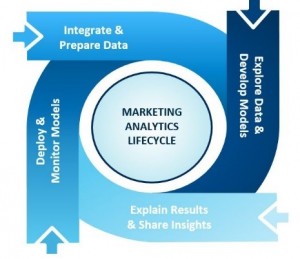Let’s talk analytics. Not in analytics in general, but rather Customer and Marketing Analytics. Both terms are, according to Google Trends, continuously trending upwards with a clear spike during the last months. Both terms are also increasingly present in our discussions with companies out there, regardless of industry. To get us going I guess a short definition of our subject is relevant:
Customer Analytics: The processes, technologies, and enablement that give brands the customer insight necessary to provide offers that are anticipated, relevant and timely.
Marketing Analytics: The processes and technologies that enable brands to assess the success of their marketing initiatives by evaluating performance using important business metrics, such as ROI, channel attribution, and overall marketing effectiveness.
Are you the kind of person who more appreciates a visual presentation of things? Check this video out.
Analytics please. Not reporting.
One VERY important aspect of both Customer and Marketing Analytics that is often overlooked is the huge difference in value and effectiveness between Reporting and Advanced Analytics.
- Reporting is a reactive and descriptive discipline aiming to tell us what has happened, when, and in the best of worlds also why.
- Advanced Analytics is a proactive and predictive discipline aiming to tell us what we should do in order to change or improve our activities. The Nirvana of Advanced Analytics is prescriptive and optimizing analytics, that tell us the best possible action in every single activity and single customer interaction. Advanced analytics can, and should, be used both in Customer and Marketing Analytics.
Why aren’t more companies and marketers applying Advanced Analytics to their practices? One reason is, that Advanced Analytics unfortunately demands a fair amount from your marketing data. Unfortunately no, or almost no, marketer is interested in data. But they should be. Only data and solid analytics from that data give them the opportunity to better than most other marketers.
Why? Because it´s all about money.
- 4-5 times higher take-rate for offers.
- Churn-prevention based on contextual real-time triggers shows a significant increase over more traditional anti-churn models/campaigns.
- Clear improvement in customer satisfaction.
The above are actual outcomes from companies having applied Advanced Customer and Marketing Analytics to their practices. As marketing are under increased pressure to show the real ROI for their activities, Advanced Analytics provides the means to improve and to show that improvement in concrete numbers.
Also, customers are more empowered and connected than ever before, with access to information anywhere, any time – where to shop, what to buy and how much to pay. Brands realize it is increasingly important to predict how customers will behave in order to respond accordingly. Simply put, the deeper your understanding of customer buying habits and lifestyle preferences, the more accurate your predictions of future buying behaviors will be.
How? People, processes and technology.
From a point of view of the analytics, we advocate managing what we call an Analytics Lifecycle. This is the process you need to get running in order to make your analytical practice successful. Is it easy? Probably not. Big data is often a big challenge, and analytically capable people do not grow on trees. More than just the analyst you will also probably need to find a data scientist, an analytically inclined marketing manager, and an IT-team that supports your analytical aspirations.
Finally; technology is probably the easiest part in this equation. There are a number of vendors out there with pretty good analytical solutions. What makes things easier for you, both in the short and long run, is to have a solution or technology that allows you to seamlessly incorporate the results of your Advanced Analytics into your customer interaction, or the customer journey if you will.
So there you have it – Customer and Marketing Analytics explained almost as briefly as possible. I hope this raised some interest and a will to learn more. In that case please visit this SAS site, Nordic blog site or global blog site.
Previous blogs:
Marketing today - easier or more difficult?
Roll up your sleeves: We are now venturing into the marketing analytics practice!

1 Comment
I like your explanation of the difference between analytics and reporting. Reporting is simply used to describe the past and present, while analytics can provide predictions and suggest how to improve. Customer analytics can show how customers can be expected to act in the future according to current trends, which can help businesses best prepare to meet the customers' needs. Thanks for all the information.